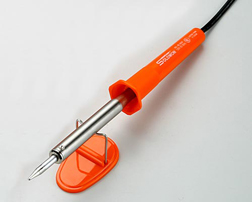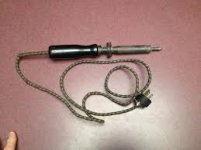My Weller tips lasted 3 days, my Antex ones last about 3 years.
My voice also goes for Antex, I have been using them for the last ten years without any complaints, the tips are great and last a long time
Have used Pace, Metcal, Weller and Hakko. Bought myself a JBC CD-B last December. Best station I have ever worked with. Not for the financially faint of heart though🙂
Just out of curiosity, I looked up the JBC CD-B..........
$400-$460.......?
USB connectivity?
Firmware upgrades?
Please!
I'll stick with my $149 Weller wtcpt........
I'm soldering, not going on the internet with it.
$400-$460.......?
USB connectivity?
Firmware upgrades?
Please!
I'll stick with my $149 Weller wtcpt........
I'm soldering, not going on the internet with it.
Just out of curiosity, I looked up the JBC CD-B..........
$400-$460.......?
USB connectivity?
Firmware upgrades?
Please!
I'll stick with my $149 Weller wtcpt........
I'm soldering, not going on the internet with it.
I've used the WTCPT, and while the things run basically forever, I've never liked them. The big thing, for me, is ergonomics. I am a reasonably small person with relatively small hands, and the very large (over 1" thick) grip on the Weller isn't very ergonomic. It's usable for point-to-point, but it's an exercise in frustration for through-hole parts like TO-92 transistors. You can forget anything SMD with it.
The WE1010 (the replacement for the WTCPT) addresses this, but I found the build quality to be lacking. Overall, it's hard for me to recommend it. I haven't had great experiences with the tips either. I think the quality of Weller stations has gone down quite a lot in the last 10 or 20 years. In my eyes, they are living on their old reputation.
A new Hakko FX-888 is a pretty big improvement over the WE1010, in my opinion. Hakko is pretty good about parts availability, even 10+ years down the road. The FX-888 uses the same tips as the 936, for example. It's a reasonable alternative for those who aren't willing to shop on the used market and can't afford to fork over the cash for a new Metcal or Thermaltronics station.
.
I bought a hot air station specifically for desoldering large DIP packages. There's an IO expander for the microcontroller on the MC450/MC650/MC1250 digital control board that sometimes fails, and it's something like 40 or 48 pins. I originally bought the hot air station for replacing them (since they were't originally socketed). It's the easiest way to take out a big DIP package without trashing the board.
Mostly though, I just use it for precision-shrinking of heatshrink tubing...
The easiest and least damaging way to remove a dead DIP part is to clip each pin at the housing, then desolder each pin individually.
Clip all the pins individually, then remove the chip housing.
Go back with the soldering iron and remove each pin. Heat the solder, then pluck the pin out with a pair of tweezers.
Now clean all the holes using a solder sucker.
Question on the T12-series stations. I noticed that the temp can be set in chunks of 10 degrees (Celcius). Or at least that are the display steps.
It also means that while in use the indicated temp sometimes alternates between two indications 10 deg C different.
Like when I set it to 370C, the display sometimes flips between 360C and 370C while in use.
My question is, is this a display thing, or does the actual temp vary over a 10deg range?
I think it is only the display, because it flips rather fast up and down and that would be too fast for the actual temp to vary.
Any opinions?
Jan
It also means that while in use the indicated temp sometimes alternates between two indications 10 deg C different.
Like when I set it to 370C, the display sometimes flips between 360C and 370C while in use.
My question is, is this a display thing, or does the actual temp vary over a 10deg range?
I think it is only the display, because it flips rather fast up and down and that would be too fast for the actual temp to vary.
Any opinions?
Jan
It will probably actually vary over that range. Go put the tip in a glass of water and water the display 🙂 My duty cycle goes from 10% to 90% when I clean the tip on a soaking wet sponge, too but it's by far the best iron I've used. The FX-888 it replaced (wouldn't make the tip hot anymore even though the iron got hot) was trash in comparison. The rotary encoder and OLED display make the menu system usable compared to the FX-888. too. The fact that you can use genuine Hakko tips in them is also nice since the T12 Shinenow, KGSER or whatever brand is 1/4 the price of the FX-951
The longevity award goes to my 60W pencil iron. I've had it for 20 years. It uses the original tip. I've forgot it plugged in for days at a time, too and the tip just wipes off. I use it for big bunches of wires and soldering ground connections when the chassis acts as a heat sink on the ground connection I'm soldering.
I use 63/37 btw.
It's one like this pic

The longevity award goes to my 60W pencil iron. I've had it for 20 years. It uses the original tip. I've forgot it plugged in for days at a time, too and the tip just wipes off. I use it for big bunches of wires and soldering ground connections when the chassis acts as a heat sink on the ground connection I'm soldering.
I use 63/37 btw.
It's one like this pic

Last edited:
Brass wool seems to be popular these days for cleaning soldering iron bits.
Unlike a wet sponge it doesn't cool the tip down.
Unlike a wet sponge it doesn't cool the tip down.
I use brass wool if the sponge can't get the tip clean. The brass is more abrasive so the tip won't last as long if always cleaned with the brass. At least in theory 🙂 The tips are only 15$ though and they come with a new heater so it's not really a big deal I guess.
The sponge for cleaning the tip shouldn't be wet. You get it soaking wet, then squeeze it out until you think it is dry. It is still damp enough that the iron won't burn it, but dry enough to not cause cooling in the tip.
The longevity award goes to my 60W pencil iron. I've had it for 20 years. It uses the original tip. I've forgot it plugged in for days at a time, too and the tip just wipes off. I use it for big bunches of wires and soldering ground connections when the chassis acts as a heat sink on the ground connection I'm soldering.
I use 63/37 btw.
It's one like this pic
Hmmmm....
Fire hazard, waiting to happen!
This is exacly why at my service bench, I have a "master kill" switch, that when I'm done, everything plugged in on the bench is shut off.
It's just good practice, and I'm sure I won't hear any objections to the contrary.
For some heavy chassis work, I have an OLD but good 100W iron.
A real brute..
Attachments
My station don't change temperature on the screen too (when it is hot). When it starts - it shows all the degrees.My question is, is this a display thing, or does the actual temp vary over a 10deg range?
Hmmmm....
Fire hazard, waiting to happen!
This is exacly why at my service bench, I have a "master kill" switch, that when I'm done, everything plugged in on the bench is shut off.
It's just good practice, and I'm sure I won't hear any objections to the contrary.
For some heavy chassis work, I have an OLD but good 100W iron.
A real brute..
+1 on a the master kill switch. It also makes it easy to kill power to everything if something catastrophic happens. I can't always test big amps on the variac, at least not under heavy load, since something like a Crest 4801 will pull far more power than my variac / isolation transformer can handle. If something blows up during a power test, it's very quick and easy to hit the kill switch.
Also, some of the new irons have a sleep feature where they shut down after a certain amount of time. I know my MX-500 shuts down if it doesn't sense a change in thermal load after 30 minutes. Sort of a nice feature, since it's really easy to leave the iron on for 3 hours after you've fixed something as you go through your extensive test procedure. Not so much a fire hazard, since you're at the bench the whole time, but it does help with the tip life.
My station don't change temperature on the screen too (when it is hot). When it starts - it shows all the degrees.
To worry about a mere 10 degree change in tip temp is kind of rediculous, don't you think?
I mean, we're talking about soldering, at an average or 600-800 degrees here.
10 degrees is trivial.
All depends what you are soldering and for who. Real Professionals have much more stringent requirements than amateurs. I've seen space qualified soldering techs in action and it's very impressive to see the results.
All depends what you are soldering and for who. Real Professionals have much more stringent requirements than amateurs. I've seen space qualified soldering techs in action and it's very impressive to see the results.
Is this the same space techs who used lead free solder and everything shorted out from whiskering ?
Hmmmm....
Fire hazard, waiting to happen!
This is exacly why at my service bench, I have a "master kill" switch, that when I'm done, everything plugged in on the bench is shut off.
It's just good practice, and I'm sure I won't hear any objections to the contrary.
For some heavy chassis work, I have an OLD but good 100W iron.
A real brute..
I still remember the fire safety movie I had to watch in 3rd grade (which was 1981 for me) featured a house fire started by a soldering iron.
That was 39 years ago.
Because of that movie I switch off the iron, wait for it to cool, disconnect the handle from the power unit, unplug the power unit, and hit the kill switch. And my iron supposedly has a 15 minute auto shutoff. As long as I remember 1 of 4 I'm safe.
To worry about a mere 10 degree change in tip temp is kind of rediculous, don't you think?
I mean, we're talking about soldering, at an average or 600-800 degrees here.
10 degrees is trivial.
We were talking about degree C as mentioned in the posts.
Jan
Hmmmm....
Fire hazard, waiting to happen!
Hardly if it's sitting in the same holder it sits in while it's being used... I didn't leave it on the carpet...
To worry about a mere 10 degree change in tip temp is kind of rediculous, don't you think?
I mean, we're talking about soldering, at an average or 600-800 degrees here.
10 degrees is trivial.
Only in the USA... The rest of us use Celsius. 😀 still, 18F isn't a big difference...
- Home
- Design & Build
- Equipment & Tools
- Inexpensive Soldering Station
